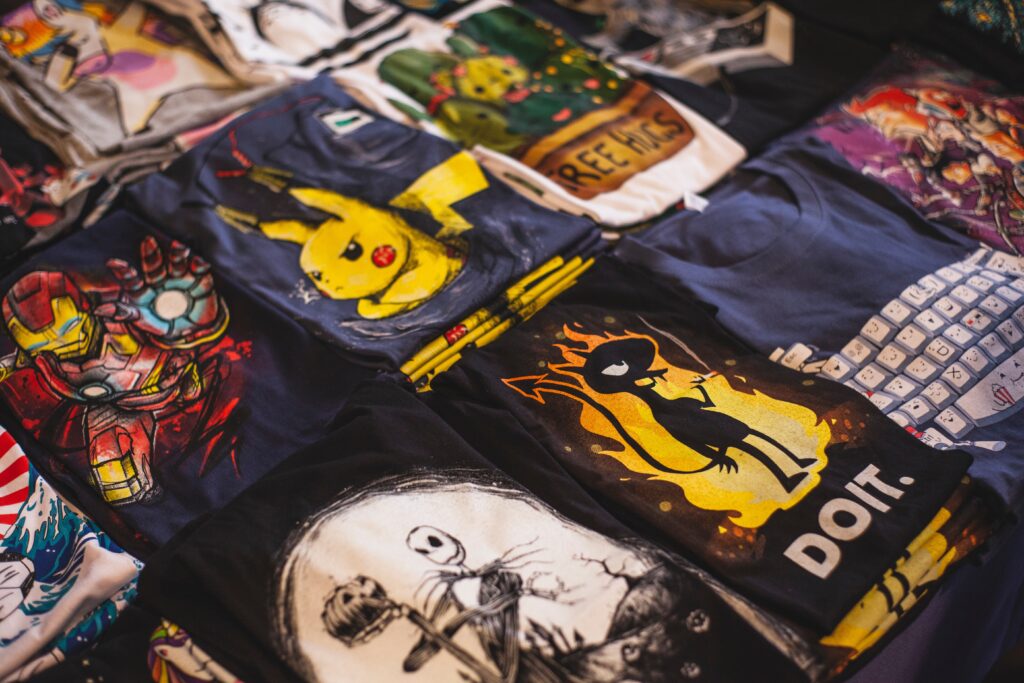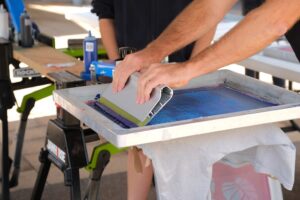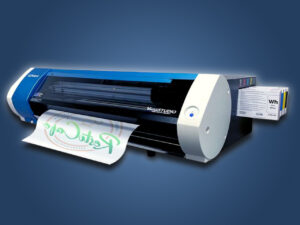
6 Most Common T-Shirt Printing Method
The art of t-shirt printing has evolved significantly, opening up a world of creativity and possibilities for businesses, entrepreneurs, and even artists. Whether you’re in the fashion industry, running a merchandise store, or simply looking to express your unique style, understanding the different t-shirt printing methods is essential. From traditional screen printing to the innovative world of direct-to-garment (DTG) printing and beyond, this article will explore the diverse techniques that have transformed the t-shirt printing landscape, catering to a wide range of audiences and industries. Join us on a journey through the colourful and intricate world of t-shirt printing, where each method brings benefits and artistic potential.
What is T-Shirt Printing
T-shirt printing, also known as apparel printing or garment decoration, is the process of applying customized designs, graphics, or text onto t-shirts and other clothing items. This process allows individuals, businesses, and organizations to create personalized and unique clothing that suits their style, brand, or promotional needs. T-shirt printing techniques vary, with some methods best suited for large-scale production and others ideal for custom, one-of-a-kind designs.
The primary goal of t-shirt printing is to transfer the desired design onto a garment, creating a lasting and visually appealing imprint. Various methods are used to achieve this, including screen printing, heat transfer, direct-to-garment (DTG) printing, sublimation, and more. Each method offers different levels of detail, colour vibrancy, durability, and cost-effectiveness, making it essential for individuals and businesses to choose the right technique that aligns with their specific requirements. T-shirt printing is widely used for personal expression, promotional merchandise, corporate branding, team uniforms, and much more, serving as a versatile and creative means to convey messages and styles through the medium of clothing.
Most Common T-Shirt Printing Method
Let’s delve into the world of t-shirt printing and explore the most common methods that bring custom designs to life on your favourite garments:
Direct-to-Garment Printing (DTG)
Direct-to-garment (DTG) printing is a modern and digital printing method used to create detailed and full-colour designs directly onto the fabric, particularly on cotton and cotton-blend garments such as t-shirts, hoodies, and sweatshirts. Unlike traditional screen printing, DTG printing does not require the creation of separate stencils or screens for each colour in the design. Instead, it works like a standard inkjet printer, where the design is created digitally and then printed directly onto the fabric.
Pros:
- Can produce highly detailed designs with intricate patterns, shading, and colour gradients. DTG printing can also reproduce a wide range of colours and shades, allowing for photorealistic prints and vibrant designs.
- Fast production process.
- DTG inks sink into the fabric. You won’t feel the print when touching it.
Cons:
- Works best on cotton and cotton-blend fabrics, and it may not adhere well to synthetic or dark-coloured materials.
- Washes out over time.
- Limited print area – can’t cover the entire t-shirt with prints
- DTG printers can be costly, which can pose an initial investment barrier for individuals looking to buy the equipment.
Best Direct-to-Garment Printers:
Texart XT-640S-DTG
Screen Printing
Also known as silk screen printing, is a versatile and widely used method for transferring designs onto various surfaces, including textiles, paper, plastic, and more. This technique involves using a stencil, or screen, to apply ink directly onto the chosen material. It’s the most popular printing method and has been around for decades – first done by hand and now by printing machines.
Pros:
- The ink is heat-cured, ensuring excellent durability, even after repeated washes.
- It works on various materials like cotton, polyester, and various blends.
- More cost-effective for larger print runs, as the setup costs are distributed across a higher quantity of prints.
- Screen printing ink is deeply absorbed into fibres, which results in stunning vibrant prints.
- Fast printing process for large amounts of T-shirts
Cons:
- Extremely small text or intricate details may not render as crisply as in other printing methods.
- Achieving vibrant colours on dark fabrics may require additional steps, such as underbasing with white ink.
- Smooth colour gradients can be challenging in screen printing, especially for designs requiring subtle colour transitions.
- Less cost-effective for small orders.
- Involves handling and mixing ink, which can be messy and time-consuming, requiring meticulous cleanup.
- Requires significant set-up time for stencils and screens.
- Wastes ink and materials, making it less environmentally friendly than DTG t-shirt printing methods.
Heat Transfer Printing Methods
All the methods listed next are essentially subtypes of the heat-press printing technique:
Dye Sublimation or All-Over Printing (AOP)
Dye sublimation, often referred to as all-over printing (AOP), is a specialized printing method used to create vibrant, full-colour designs that cover the entire surface of a fabric or textile, typically used for apparel, sportswear, and promotional items.
The desired design is digitally printed onto a special transfer paper using sublimation ink. Sublimation ink is unique because it transforms from a solid to a gas when exposed to heat, skipping the liquid state. The printed transfer paper is placed onto the fabric, with the design facing down. The transfer paper and fabric are then subjected to high heat and pressure using a heat press machine. When the heat is applied, the sublimation ink on the transfer paper transitions into a gas and permeates the fibres of the fabric. As it cools, it returns to a solid state, becoming permanently embedded within the material
Pros:
- Produces incredibly vibrant and detailed designs that cover the entire fabric from seam to seam.
- Results in designs that are seamlessly integrated with the fabric, providing a soft, smooth feel with no texture or raised areas.
- Highly durable and resistant to fading, cracking, and peeling, even after numerous washes.
- The sublimation process doesn’t clog fabric pores, allowing the material to retain its breathability, which is especially important for sportswear and activewear.
Cons:
- Works best on fabrics with a high polyester content or special coatings. Natural fabrics like 100% cotton are less suitable, as they don’t hold the ink as effectively.
- Achieving vibrant colours on dark fabrics typically requires a white base layer, adding an extra step and potentially increasing production time and cost.
- Requires specialized equipment, including sublimation printers and heat press machines, which can be an initial investment for businesses.
- May not be the best choice for simple, single-colour designs or designs with large blocks of solid colour.
- Sublimation inks are heat-activated, meaning designs cannot be applied retroactively to finished garments, limiting the ability to modify existing apparel.
Direct-to-Film Printing (DTF)
A digital printing technique used to transfer vibrant and detailed designs onto various fabrics, such as apparel, accessories, and textiles. It involves using a specialized printer to create the design directly onto a heat-sensitive film, which is then transferred onto the fabric using heat and pressure. This method has gained popularity as a versatile and cost-effective way to produce full-colour, high-resolution prints on textiles.
Pros:
- Works well on various fabric types, including cotton, polyester, and blends, providing flexibility in garment selection.
- Allows for the reproduction of full-colour designs with no limitations on the number of colours used.
- Prints are durable and withstand washing and wear.
- Cost-effective for small to medium print runs, as there are no setup costs or minimum order requirements.
Cons:
- The quality and durability of the printed film can vary depending on the brand and type of film used, which may affect the final print’s quality and longevity.
- Can be slower compared to some other digital printing methods, as it involves multiple steps, including film lamination and heat transfer.
- Can only be used on smaller items like t-shirts, cushion covers or face masks
- More complex than dye sublimation or DTG printing
Best Direct-to-Film Printer: VersaStudio BN-20D Direct-to-Film Printer
Heat Transfer Vinyl Printing
Also known as iron-on vinyl, is a versatile and popular method for adding designs, text, and graphics to various fabrics and textiles. This process involves cutting vinyl sheets or rolls into specific designs, which are then heat-applied to a fabric surface.
Pros:
- Best for sports team t-shirts
- Durable and can withstand frequent washing and wear
- Various types of HTV materials are available, including glitter, metallic, reflective, and more
- Works on any fabric
Cons:
- Highly intricate and detailed designs may be challenging to cut and weed, leading to increased production time.
- Works best on light-coloured fabrics, as the vinyl’s colour may not stand out as effectively on dark textiles.
- Overlaying multiple layers of HTV can sometimes result in a bulkier and less flexible finish.
- Can be labour-intensive and time-consuming for large production runs compared to other printing methods
- Can only be used for text-based designs
Plastisol Transfer Printing
This process involves creating designs on transfer paper using plastisol ink, which is a type of screen printing ink known for its durability and vivid colors.
Pros:
- Plastisol inks can resist fading, cracking, and peeling, even after numerous washes.
- Can be prepared in advance and stored, enabling efficient and cost-effective production for large orders.
- Can be used on a wide range of fabric types, including cotton, polyester, and blends.
- Great for creating t-shirts with the same design but small differences, Example: sports team t-shirts, where you need to change names or player numbers
Cons:
- Can’t print photo t-shirts
- Can only print full tones
- Not ideal for large t-shirt quantities, as each product requires its own paper print
Additional “Printing” Method
Embroidery
While it’s not a traditional “printing” method, it is one of the oldest methods of embellishing textiles and is still widely practiced today. Embroidery is a decorative art form that involves stitching designs, patterns, and images onto fabric using thread or yarn. it can be done by hand with a needle and thread, but it is also commonly achieved using computerized embroidery machines for precision and efficiency.
Pros:
- Often associated with a high-quality and professional appearance, making it suitable for corporate logos, monograms, and branding.
- Can be applied to various fabrics, including cotton, denim, fleece, and more.
- No dyes involved
Cons:
- Can be more expensive than other customization methods
- Works best on flat or slightly curved surfaces. It may not be suitable for all types of fabrics or three-dimensional items.
- Not suitable for detailed designs
Airbrushing
Airbrushing is a printing technique that involves using an airbrush tool to spray a fine mist of paint or ink onto a surface. This is very different from all the other t-shirt printing methods mentioned above, as it does not require any transfer paper like sublimation printing or any other heat press technique. Actually, it does not require any DTG printers or other machines at all. Airbrushing is completely manual work done by hand.
Pros:
- Can be used on various surfaces, including paper, canvas, fabric, metal, and plastic.
- Allows artists and professionals to create custom colours and effects
- Cheap production cost
Cons:
- Overspray, which is the unintended dispersion of paint beyond the intended area, can occur and may require additional masking or cleanup.
- Proper ventilation and safety precautions are necessary when using airbrushes, as inhaling paint or ink fumes can be harmful to health.
- Results in lower design quality
- Prints aren’t long-lasting
In conclusion, the world of t-shirt printing offers a colourful spectrum of methods, each with its unique characteristics and applications. Whether you seek the vibrant and durable results of direct-to-garment printing, the traditional charm of screen printing, the vivid and all-over coverage of dye sublimation, the precise and photographic quality of direct-to-film printing, or the versatility of heat transfer vinyl, there’s a method to suit every need and creative vision. As the art and technology of t-shirt printing continue to evolve, the possibilities for customizing and expressing oneself through apparel are boundless. So, whether you’re an artist, a business owner, or someone looking to make a fashion statement, the world of t-shirt printing invites you to explore and wear your creativity with pride.
Are you a business owner looking to elevate your apparel customization game? Consider investing in direct-to-garment printing machines. Contact us today to explore your options and take the first step toward enhancing your business with the latest in t-shirt printing technology. Let’s turn your creative vision into a colourful, wearable reality!











